The Delahaye years
1933-'35: why Delahaye decided to go racing
Author
- André Vaucourt
Date
- October 28, 2012
Related articles
- Delahaye - René Dreyfus and the upset at Pau, by Leif Snellman
- Delahaye 135 - 1935-'36: a new chassis for the luxury market, by André Vaucourt
- Delahaye 135 - 1936: dominating the 1936 French racing season, by André Vaucourt
- Delahaye 135 - 1936: Delahaye wins nine out of 18 races, by André Vaucourt
- Delahaye 135/145 - 1937: winning big prizes, by André Vaucourt
- Delahaye 135/145/155 - 1938: Delahaye wins the Pau and Cork GPs and comes 1, 2, 4 at Le Mans, by André Vaucourt
- Delahaye 135/145 - 1939: not a very good year for Delahaye, and a terrible year for the world, by André Vaucourt
- Delahaye 135/145/155 - 1945-'46: after five years of war, by André Vaucourt
- Delahaye 135/145/155 - 1947-'48: racing with cars over 12 years old, by André Vaucourt
- Delahaye 145 - What became of the Delahaye 145 V12 chassis no. 48771?, by André Vaucourt
- Delahaye 145 - The history of Delahaye 145 V12 chassis no. 48775, by André Vaucourt
- Delahaye 145 - The brief history of Delahaye 145 V12 chassis no. 48772, by André Vaucourt
- Delahaye 145 - The short history of Delahaye 145 V12 chassis no. 48773, by André Vaucourt
- Delahaye 155 - Delahaye's 155 V12 chassis no. 48774: the worst car they ever built, by André Vaucourt
Who?"Michel Paris"/Marcel Mongin What?Delahaye 138 Sport Where?Le Mans When?1935 Le Mans 24 Hours |
 |
Why?
After it was founded, the Delahaye company took several decades before deciding to enter the sports and racing car scene. Apart from a few races in the period between 1896 and 1903, nothing was attempted until 1933.
It was at the height of the Great Depression in France that the major shareholder and head of the family-owned company, 66-year-old Madame Léon Desmarais, took the bold and unexpected decision not to go into mass production. Instead, she decided that it would be wise to produce less cars, and make them better, faster and more luxurious. Furthermore, these cars would be honed in a competition environment.
The decision was accepted by all concerned and immediately a small racing department was set up, headed by 72-year-old Amedée Varet and assisted by 43-year-old engineer Jean François, who had just joined the firm and was responsible for a new line of cars called the Superluxe.
There was no time to design and develop new chassis, so existing chassis were used, modified at the front to accommodate an independent suspension and powered by the modern and robust Type 103 engine for the 6-cylinder cars and the extrapolated 4-cylinder engine for the smaller cars.
In May 1933, two Type 126M cars, the forerunner of the 138 Superluxe, and two 28-seater buses on the 4-ton chassis were engaged in the Tour de France Automobile, and all won a gold medal for having covered the 5000kms without a penalty. Remarkable is the fact that the same basic engine, the Type 103, was used in both the cars and the buses.

The two cars and the two 28-seater buses, powered by the same Type 103 basic engines, which completed the Tour de France Automobile in 1933, with no penalties, and won four gold medals.
After these very encouraging results a Type 138 Superluxe had a test run at Monthléry in the summer of 1933, covering 500kms at just over 158kph, achieving 158.673kms in one hour.
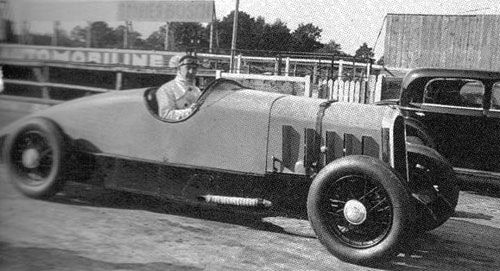
The test car at Montlhéry, driven by Albert Perrot, completed 500km at just over 158kph.
At the Paris Motor Show in October 1933, the new models were unveiled.
| type | cv* | capacity | bore & stroke | bhp | wheelbase | speed |
| 132 Superluxe | 10 | 1832 | 73,8 x 107 | 34 | 2m86 | 110kph |
| 134 Superluxe | 12 | 2150 | 80 x 107 | 45 | 2m86 | 115kph |
| 138 Superluxe | 18 | 3227 | 80 x 107 | 90 | 3m16 | 125kph |
* Fiscal horsepower, a typically French taxable horse-power rating that has nothing to do with the actual horsepower of a car.
The sporting models were not yet announced, but the wealthy sportsmen and women were well aware of their construction, and orders began to trickle in. They were impatient to test the new cars in rallies, hill climbs and local races, and the results were immediate:
| month | 1934 events | car | driver | result |
| Jan | Monte Carlo rally | 92RG8 | Perrot | 24th |
| Feb | Paris-St Raphael rally | ? | Mrs Nenot | 1st |
| 92RG8 | Miss Gonnot | 2nd | ||
| 1821RJ1 | Mrs Schell | 4th | ||
| Mar | Chanteloup hillclimb | 92RG8 | Perrot | 1st in class |
| Mar | Paris-Nice rally | 92RG8 | Mrs Schell | 1st of the ladies |
| Apr | Chateau Thierry hillclimb | 92RG8 | Perrot | 1stin class |
| May | Monthléry Records | - | Perrot/Dhome/Girod | 4 world records |
| Jun | Harfleur hillclimb | 2536RG1 | Perrot | 1st in class |
| Jun | Vosges circuit | 1536RG1 | Perrot | 1st |
| Jul | French Alpes rally | 1821RJ1 | Mrs Schell | 1st in class |
| Aug | International Alpine Cup | 2537RJ1 | Perrot | Team cup |
| Dhome | 4243RJ2 | |||
| 4884RG2 | Girod | |||
| 92RG8 | Mrs. Schell | Ladies cup | ||
| Oct | Algerian GP Tourism | 2537RG1 | Perrot | 1st |
Mrs Schell, better known as Lucy O’Riley Schell, the American millionaire of Irish origin, and her husband Laury who had been engaged in motor sports for a number of years were strong supporters of Delahaye, also financially.
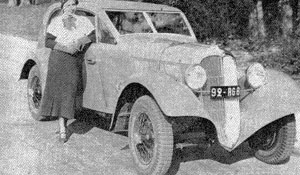
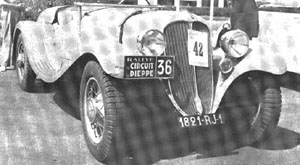
Left: Lucy O’Riley Schell with the very first 138 Sport, probably coach-built in a clumsy way by the small Delahaye racing department workshop. Right: This was Lucy's favourite, coach-built by Figoni, a very elegant and fast roadster.
Albert Perrot was the works test driver and along with Marcel Dhome and Armand Girod, two other test drivers, Perrot broke no less than four world records driving in a special 138 monoplace bodied by Figoni, on the 8th, 9th and 10th of May:
- 4000 miles at 177.669kph
- 5000 miles at 176.853kph
- 48 hours at 176.294kph
- 10000 km at 168.527kph
Furthermore, he also broke 11 international records! The fastest speed recorded was 193 kph.
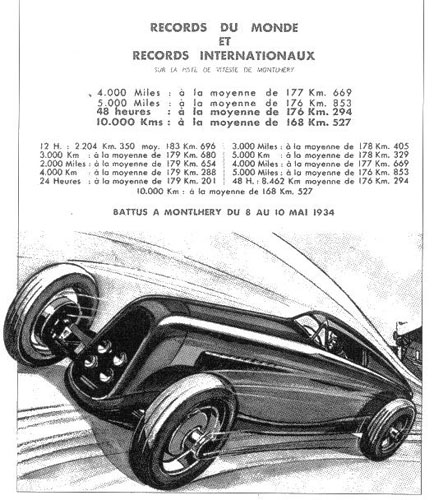
The 138 monoplace broke four world records and 11 international records in May 1933.
At the Paris Motor Show in October 1934 two new models were on display, and the name Superluxe had disappeared. The 138 Sport carried one carburettor whereas the 138 Coupe des Alpes sported three carbs.
| type | cv | capacity | bore & stroke | bhp | wheelbase | speed |
| 138 Sport | 18 | 3227 | 80x107 | 95 | 2m86 | 135kph |
| 138 Coupe des Alpes | 18 | 3227 | 80x107 | 113 | 2m86 | 145kph |
The 1935 racing season opened with the Monte Carlo rally. A 135 Special (or 135S), the racing car, was present for the first time at the next Monte.
| month | 1935 events | car | driver | result |
| Jan | Monte Carlo rally | 44430 | Lucy/Laury Schell | 3rd |
| Mar | Paris-St. Raphael rally | 7442RG4 | Germaine Rouault | 2nd. |
| 44430 | Lucy Schell | 3rd | ||
| Mar | Canteloup hillclimb | 44430 | Albert Perrot | 1st in class |
| Apr | Paris-Nice rally | 44430 | Lucy Schell | 4th |
| 4884RJ2 | Laury Schell | 8th | ||
| 7442RJ4 | Germaine Rouault | 18th | ||
| May | Tour de France Auto | 45513 | Albert Perrot | 1st |
| 44430 | Lucy Schell | DNF | ||
| May | Orleans speed race | 45513 | Albert Perrot | 1st |
| 44430 | Lucy Schell | 2nd | ||
| Jun | Vosges circuit | 45513 | Albert Perrot | 2nd in class |
| Jun | Le Mans 24 Hours | 45497 | “Paris”/Mongin | 5th |
| Jun | Lorraine GP production cars | 44430 | Lucy Schell | 1st |
| 7442RJ4 | Germaine Rouault | 3rd | ||
| ? | Armand Girod | 4th | ||
| Jul | French Alpes Rally | 45513 | Albert Perrot | 1st |
| Jul | Mont Ventoux hillclimb | 45513 | Albert Perrot | 1st |
| Jul | Reims GP tourisme | 45513 | Albert Perrot | 1st |
| 45497 | “Michel Paris” | 2nd | ||
| 44430 | Lucy Schell | 6th | ||
| 7442RJ4 | Germaine Rouault | 7th | ||
| Aug | Pescara 24 Hours | 45497 | Mongin/”Paris” | 3rd in class |
| Sep | Lapize hillclimb | 7442RJ4 | Germaine Rouault | 1st in class |
| Jan 1936 | Monte Carlo rally | *1707RK* | Lucy/Laury Schell | 2nd |
| 45538 | Jacques Ambaud | 12th | ||
| 45496 | Siko/Des Forest | 44th | ||
| 45537 | Caylac/Fontgnac | DNF | ||
| 45533 | Paul/Foch | accident |
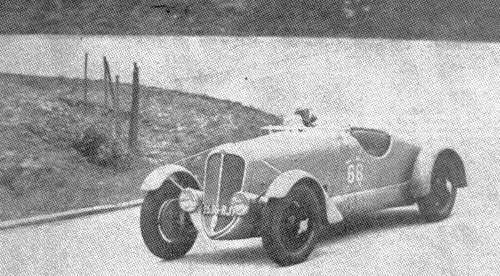
Albert Perrot drives the works roadster to victory in the Tour de France Automobile, with no penalties, and wins a gold medal, the Ansaldo Cup, the Coupe de l’Auto and the ACF Cup.
Only 300 Type 138 chassis were built. Of all these 138 Sport and Coupe des Alpes racing cars, only two survive today in private collections, as can be seen in the following table. The table also connects the registration numbers to the chassis numbers, which are not always known. The first 135S is of course the Schell car, *1707RK* which will be described in the next part of this series.
| date | reg.no. | chassis no. | first owner | other owners | 2012 status |
| 12/33 | 92RG8 | ? | works | Schell | lost |
| 6/34 | 1821RJ1 | 44430 | Schell | destroyed | |
| 6/34 | 2536RJ1 | 45513 | works | Soulié/Pastoriano/Rigodon/ Thibaud |
lost |
| 6/34 | 2537RJ1 | ? | works | lost | |
| 7/34 | 4234RJ2 | ? | works | lost | |
| 7/34 | 4884RJ2 | ? | works | lost | |
| 12/34 | 7442RJ4 | ? | Rouault | lost | |
| 4/35 | 9782RJ6 | 45497 | “Paris” | Bellecroix/Grignard/Meyrat/ Pozzi/de Tudert |
lost |
| 6/35 | 6200RJ8 | 45533 | Ambaud | Bérard/Beach | lost |
| 6/35 | 6201RJ8 | 45538 | Ambaud | AGASI/Pozzoli/Marçais | Honneger |
| 6/35 | 6202RJ8 | 45496 | Ambaud | Bittel/Merlin/Vendiesse/ Casaliere/Charbonneaux/ Seydoux/Charbonneaux |
Mestivier |
| 6/35 | 6203RJ8 | 45537 | Ambaud | lost |
The first seven of these cars were left-hand drive, and 'high-level chassis' on their 18” wheels. The last five were RHD on semi-lowered chassis, also on 18” wheels.
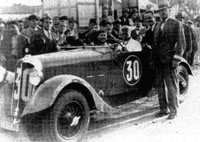

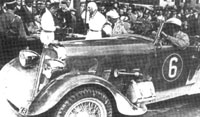
These three 138 Coupe des Alpes roadsters, driven by Perrot, Dhome and Girod, the works test drivers, win the Alpine Cup team prize of 1934. The photo of no.30 was taken the 1935 Algerian GP, won by Perrot as usual, as one could say. No.5 is Marcel Dhome's car at a control at Zagreb and no.6 is Armand Girod's car at a control at Munich, both during the 1934 Alpine Cup.
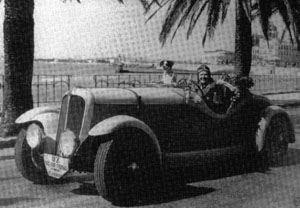
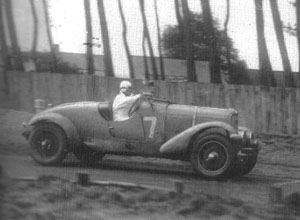
Left: Germaine Rouault, a formidable lady driver, would use her imposing 138 roadster during 1935-'37. She is seen here after having won the Paris-St.Raphael ladies rally in 1936. We shall see her again, driving a 135S with great success in 1938 and 1939. Right: Delahaye's first attempt at the Le Mans 24 Hours on June 15-16, 1935. Driven by “Michel Paris” (his real name was Henri Toulouse) and his partner Marcel Mongin the car obtained an honourable 5th place. The car had many owners and was rebodied four times until it disappeared in the late fifties in Morocco when owned by count Yves Georges de Tudert.

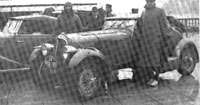

Left: Jacques Ambaud, a wealthy sportsman from Marseille, ordered four cars from Delahaye, had them coach-built by Chapron and registered them the same day in Paris in June 1935. All four were entered in the Monte Carlo rally in January 1936. Middle: here we see Jacques in front of the massive 138 Coupe des Alpes he drove alone. He came in 12th. Right: here we see car no.24 driven by Paul/Foch after a collision with a truck. They obviously did not finish.
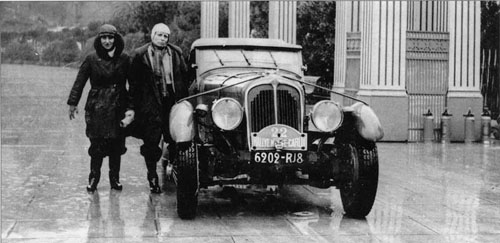
Mesdames Siko and Des Forest in car no.22 came in 44th. Unfortunately, there is no photo of car no.23 driven by Cayla/Frontgnac, who did not finish.
On August 19, 1935, an official Delahaye price list introduced the last development of the Type 138, which was the 'Type 135 Competition'. Alongside the 'Type 135 Sport' and 'Type 135 Coupe des Alpes', these cars were still on the old 2m86 wheelbase chassis, semi-lowered and with 18” wheels. These were not 135s as such but '138', an astute transition between the well-known 138 line and the new 135 line which would be unveiled at the Paris Motor Show in October 1935.
The 138 Competition was identical to the 138 Sport or the 138 Coupe des Alpes, but with a 3.5-litre engine of 84mm bore and 107mm stroke, a displacement of 3557cc producing 20cv/120bhp, with three carburettors and a maximum speed of around 155kph.
